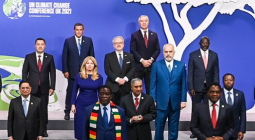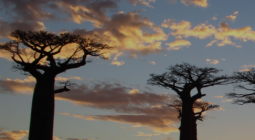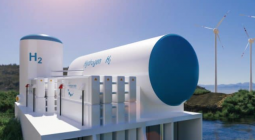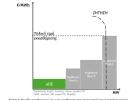Engineering the future: meet the Africa prize shortlist innovators
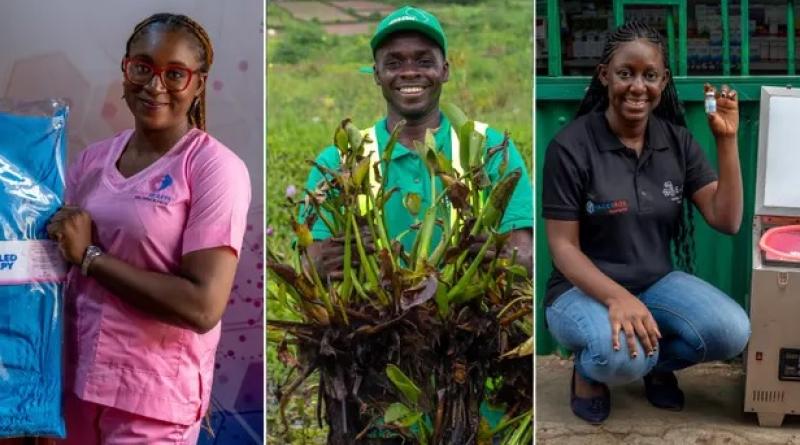
Turning invasive plants into a force for good and powering healthcare with solar – here are three of the 2022 nominees
From a solar-powered crib that treats jaundiced babies to fibre made from water hyacinth that absorbs oil spills, innovators from nine African countries have been shortlisted for the Royal Academy of Engineering’s 2022 Africa prize.
This year half of the shortlist of 16 are women, and for the first time it includes Togolese and Congolese inventors. The entrepreneurs will undergo eight months of business training and mentoring before a winner is chosen, who will receive £25,000, and three runners-up, who win £10,000 each. All the projects are sustainable solutions to issues such as access to healthcare, farming resilience, reducing waste, and energy efficiency. The Guardian spoke to three of the shortlisted candidates.
Virtue Oboro, Nigeria
Soon after her son, Tonbra, was born in 2015, Virtue Oboro’s mother noticed the baby’s eyes and skin looked yellow and they rushed him to hospital in Yenagoa, in the southern state of Bayelsa. But three of the hospital’s five phototherapy units for jaundiced babies were faulty and the other two were in use.
Tonbra was eventually found a place in a phototherapy unit but, when there was a power cut, he developed severe jaundice. “He had to have an emergency blood transfusion, which was traumatising. We had to buy blood from an external source, which made us nervous. It was really tough,” says Oboro, 32, a graphic artist and product designer.
Her boy recovered, but the experience inspired Oboro and her husband to form Tiny Hearts Technology, the creators of Crib A’Glow, a solar-powered portable phototherapy crib that treats and monitors jaundiced newborns. So far, about 300,000 babies have been treated directly with the cribs in hospitals and homes in Nigeria and Ghana.
Today, the Tiny Hearts team comprises engineers, designers and paediatricians, and also educates health workers and pregnant women about jaundice, which Oboro believes has saved many more babies. “I didn’t spot the symptoms myself,” she says. “Like many new mothers, I didn’t know about jaundice.”
Newborns develop jaundice when their levels of bilirubin – a natural substance formed when red blood cells break down – are abnormally high. It can lead to death and also cause brain damage, cerebral palsy and hearing loss. Although it is common – affecting about 60% of newborns worldwide – devices to treat babies with blue-light therapy are expensive and unsuitable for poorly resourced hospitals with unreliable electricity.
About 100,000 deaths from jaundice are recorded annually and many more babies suffer permanent injury.
It took Oboro five attempts to perfect the design for Crib A’Glow, which runs on solar power, is foldable and costs about a tenth of phototherapy devices used in developed countries. The light rays focus on the baby’s body to ensure maximum efficiency, and using LED lights avoids skin burns, dehydration and rashes that can be common side-effects of such devices, she says.
“Not only does the crib provide access to phototherapy, it provides phototherapy that is sustainable and lasts long enough for the baby to recover. This also reduces congestion in hospitals in Nigeria because babies recover more quickly,” says Oboro, adding that the cribs can be moved next to their mothers’ beds during treatment.
“Because of Covid, other causes of infant mortality, such as jaundice, have not been given much attention. But Covid didn’t make the other problems go away.
“The crib will reduce infant mortality and disabilities in Nigeria, and make the job of healthcare workers easier,” says Oboro, who is developing a solar-powered incubator and hopes to form partnerships with development agencies and donors to take her innovations across the continent. The crib is already used in 70 hospitals across Nigeria.
“We import a high proportion of medical devices – but it is important to have homegrown solutions that are accessible and affordable for every community here. Healthcare providers can quickly provide feedback on homegrown devices,” she says.
“The hardest part for us was acceptability. At first, it was difficult to convince people the crib would be effective,” Oboro says, “partly because I’m not from a medical background. But it’s as if a battle was fought and won – now my son and I feel like winners every day.”
Divin Kouebatouka, Republic of the Congo
So destructive is the water hyacinth plant to lakes and rivers in Africa that fishermen call it “the curse”, says Divin Kouebatouka, a 32-year-old engineer who is the first Congolese innovator on the shortlist.
“When I returned to my mother’s village on the banks of Lake Djoue after studying engineering abroad, I saw an invasive plant that had literally invaded the lake, blocked marine navigation and asphyxiated the fish,” he says. “It had halted fishing activity, which is the main economic resource of the village.”
Kouebatouka, a Colorado State University graduate who says he is motivated by protecting the environment after being struck by the impact of the climate crisis on the Congo at a young age, began to think about possible benefits of the water hyacinth plant, which is native to the Amazon basin but now found across the world and whose rapid spread has been intensified by global heating.
“We studied the properties of hyacinth and found it is rich in nitrate, which is good for compost; rich in protein, which is good for animal feed; and it has a high absorbency,” he says. “It could also solve another environmental problem: the leakage of oil – the main cause of marine pollution in the Congo. So we decided to create a ‘bridge’ between two environmental problems – each one should be a solution to the other.”
His team at Green Tech Africa developed a way to turn the plant’s stems into highly absorbent fibre that can suck up oil from the ground or water, or plug an oil leak in a container. Today more than 10 companies buy the product, called Kukia, which can hold up to 17 times its weight in hydrocarbons, the compounds that form the basis of crude oil. In 2018 the idea was nominated for the African entrepreneurship award.
The Republic of the Congo has large reserves of crude oil and natural gas. Oil spills are common in industrial processes and the automotive and shipping industries. Kukia is sold to petrochemical and pollution control companies and the public through fuel stations and wholesalers.
The project has also provided employment for local people who collect the plant and produce the fibre, earning more than the average agricultural wage. There are almost 900 collectors, 80% of whom are women.
“We collected more than 5,000 cubic metres of water hyacinth – equivalent to two football stadiums of water hyacinth – on the banks of the Congo River, which made it possible to restore the waterways, promote the resumption of fishing and restore economic activities for a population of more than 100,000 people,” says Kouebatouka.
“Parts of the plant that aren’t useful for the fibre are used elsewhere – roots are composted and leaves turned into animal feed. Once the stem fibre has been used on an oil spill or leak, it can be repurposed as a fuel source by cement factories,” he says.
For Green Tech Africa, the next step is to establish a biorefinery to produce energy and a range of products from the invasive plants. “We’ve turned a botanical problem into a solution for an environmental problem, creating employment and skills development along the way. Kukia is simple, scalable and effective, and can make an enormous difference in Congo and worldwide.”
Norah Magero, Kenya
“I get emotional when I think about how many children missed out on vaccinations because of Covid,” says Norah Magero, a mechanical engineer. “The pandemic put huge pressure on hospitals and healthcare workers. In Africa, 23 million children [under the age of one] did not get vaccinated because of Covid.”
In Kenya, the pandemic highlighted the lack of “cold-chain” infrastructure for storing vaccines, which 33-year-old Magero experienced. “Soon after I had my child in 2018, I moved from Nairobi to a rural area. I realised it was really hard to get her vaccinated. There were so many blackouts and ice-packs melted, so vaccines were no longer viable.
“Digging deeper, I realised the problem was not just the lack of reliable power, but also that women who had gone once or twice to get the vaccines might not go back a third time. It might be expensive or difficult to travel and so they just gave up. I might have had the same thought myself – this is just too difficult.
“I am an engineer and an energy manager and so I asked myself: why isn’t there an engineering solution to this problem. I am passionate about bringing up technology because it plays a huge role in closing the gaps. But it has to be affordable.”
The organisation Magero founded, Drop Access, hopes to close the gap with VacciBox, a mobile solar-powered fridge that safely stores and delivers temperature-sensitive vaccines to communities and hospitals where there is a lack of cold-chain infrastructure.
“Hospitals are in a race against time with vaccines and that is the case in most rural communities,” she says. “We need a solution to stop thousands of people missing out on life-saving vaccines.”
The solar fridge has a data-monitoring facility and battery backup so it does not run out of power. Costing €800 (£680) to produce, the 40-litre box can be carried on motorbikes, bicycles and boats.
“So far, we have piloted the fridge at two rural healthcare facilities. The first is at Merrueshi village health centre in Kajiado county in Kenya, located in a Maasai conservancy. The facility faces frequent power outages and used to use a soda fridge to store vaccines. It is the nearest health centre for a population of at least 400,000.
“Every Wednesday, Maasai women would walk for miles to bring their children to be vaccinated. Currently, with VacciBox, the health centre can conduct field-based and door-to-door vaccinations, which has increased their monthly vaccination numbers by 150%.”
The second trial is at the Usungu dispensary in Makueni county, 14 miles (22km) from the nearest electricity grid. The health worker used to transport vaccines twice a week from the nearest hospitals and return what was left at the end of the day or when ice-packs began to melt. With VacciBox, the dispensary can stock up to 1,000 vaccines a week without worrying about the vaccines spoiling.
Magero says so far the team has carried out 2,100 vaccinations, mostly of children, and intends to expand into Covid vaccinations. “The AstraZeneca vaccine operates within that 2C to 8C [35.6F-46.4F] temperature range we cover,” she says.
By 2024, she hopes to have produced 1,500 units and to have vaccinated 3 million children. The box can also be used to transport blood and tissue and can be monitored remotely before deciding to send out a technician if it stops working. An app helps keep track of the condition of the unit as well as the stock and distribution.
“Throughout this process, I have been through a range of emotions – from frustration to scepticism to pride,” says Magero.
“I had the feeling that I cannot just vaccinate my daughter – she needs classmates and friends. So this is for the mothers – and for all of Kenya.”
Cover photo: Africa prize 2nominees, from left: Virtue Oboro from Nigeria, Divin Kouebatouka from the Republic of the Congo, and Norah Magero from Kenya. Composite: RAEng



